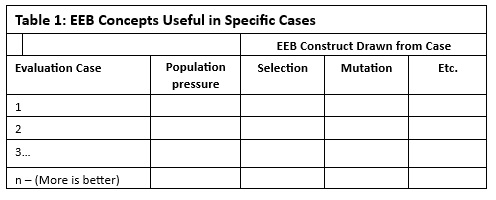Can Ecology and Evolutionary Biology Provide Unique Evaluation Insight?
I have been making a determined effort to probe this question. It started with a casual thought that was lurking in my mind for a long time, namely, that one could look at a program as an organism moving on a fitness landscape.
A few years ago I began to take this idea seriously. Do the fields of Ecology and Evolutionary Biology (EEB) have anything to say to Evaluation other than casting familiar concepts and methodologies into a new language?
The language of EEB is certainly not part of our common parlance. I have yet to read an evaluation report that cast models or program theory in terms of interactions among concepts such as rates of population change, species birth and extinction, topography of fitness landscapes, coevolution, movement within an ecosystem, competitive and synergistic relationships, or any of the numerous other concepts that populate the daily thought processes of ecologists and evolutionary biologists. Nor have I seen any data analysis that takes these concepts into account.
The idea of an EEB perspective in Evaluation is intuitively appealing. At least it is to me and to many colleagues that I have discussed this idea with. The question though, is whether it is worth the trouble for evaluators to take EEB seriously. The fundamental question is:
Can an EEB lens provide insight that would not come from our traditional methods and theories?
How can the question be answered?
It is impossible to answer this question in the abstract. Case-based data must be collected, and the data must be set within an analytical strategy. I envision the data being organized as shown in Table 1.
The analytical strategy is to:
Determine which EEB concepts are applicable in Evaluation (as per Table 1).
- Discern the contribution of each EEB concept to the particular case.
- Assess whether applying the EEB concept provides insight into the case that would not come from a traditional evaluation.
- Move from concept to methodology. Determine whether EEB analytical methods provide insight that would not come from our usual methodologies.
- Generalize from the evaluation of cases to Evaluation.
This is an ambitious research agenda, but right now I am pursuing a more modest goal. I want to populate Table 1.
Invitation
I am a member of an informal group of people who are discussing EEB in evaluation. We are collecting cases. If you have any that you suspect might contribute to our Quest, please send me an email at jamorell@jamorell.com.

